How to Create a Website Conversion Funnel (Examples)
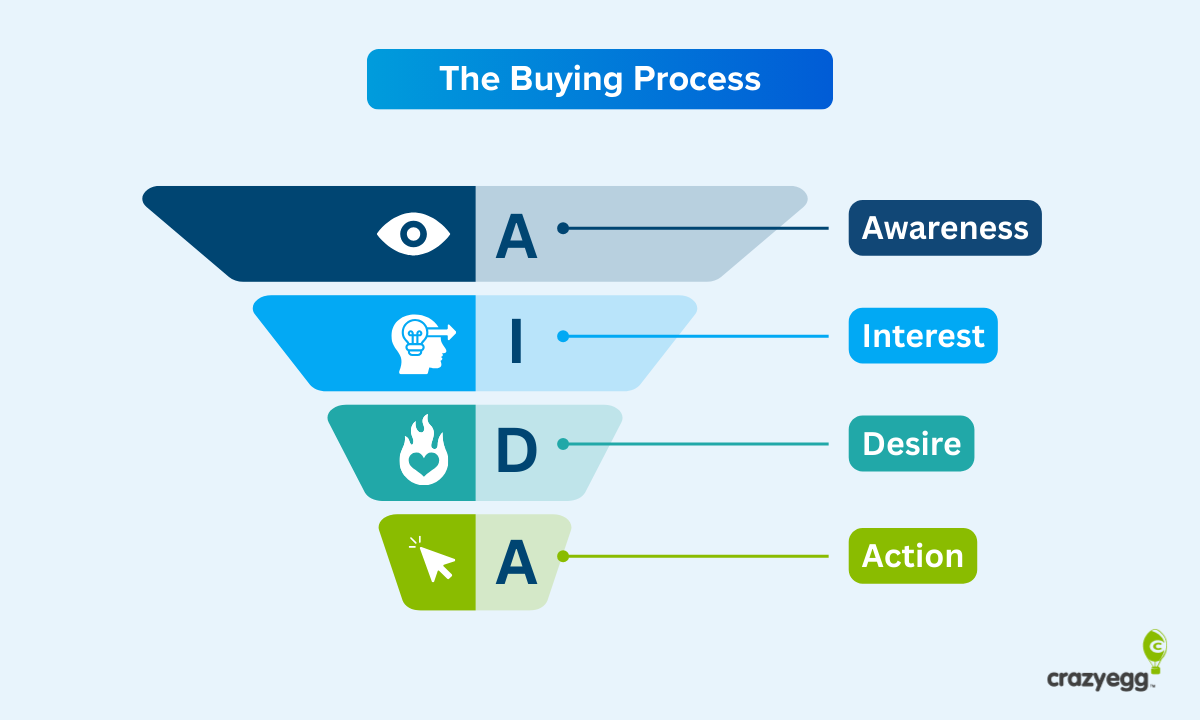
Your website has a funnel, whether you have built it purposefully, or not.
The question is: how well is your funnel working to convert casual visitors into actual customers?
Learn how to build an effective funnel, with examples from high-performing sites you can copy.
What Is a Website Funnel?
A website funnel is a way to visualize how potential customers on your site turn into paying customers. You can use it to understand why some people take action, and why others leave without buying, donating, signing up, and so on.
That’s it. Website funnels cannot “push” users in any direction. They don’t capture the visitor-to-customer transformation perfectly.
They are useful because they help teams talk with a shared language about the always-messy process by which a real person decides to become one of your customers.
Once you understand this process, you can monitor activity in your funnel and take steps to improve the conversion rate and increase revenue.
What does a website funnel look like?
Think of the shape of a funnel: wide at the top and narrow at the bottom. The wide top represents the total number of people who enter your site. The narrow bottom represents the smaller subset of users that complete a purchase.
Here’s a simple diagram with a visualization of a website funnel:
In this example, the buying process is broken down into four key stages:
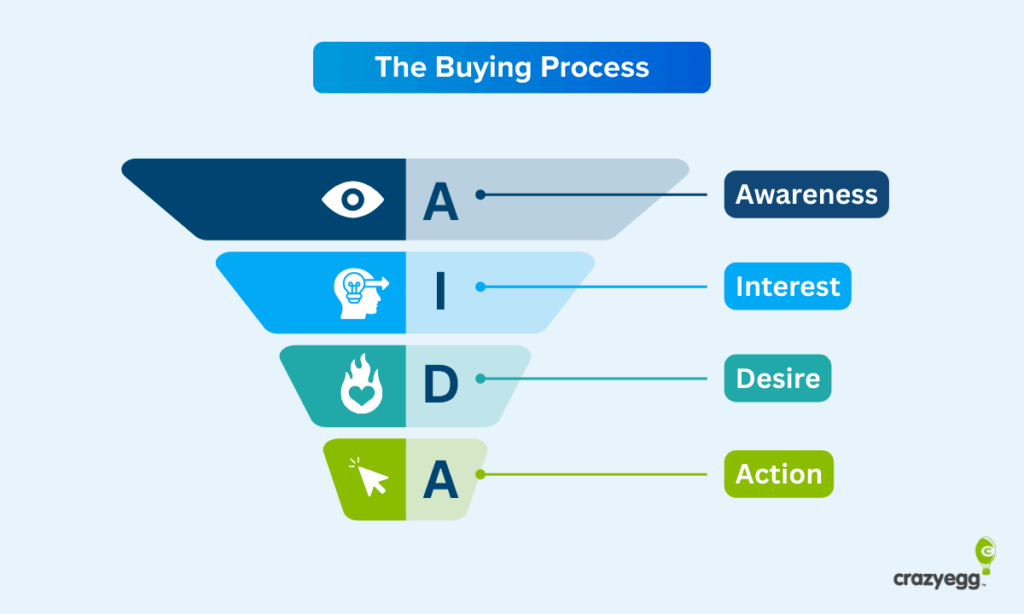
- First, your potential customer becomes aware of you or your product. Once they visit your website, their activity is logged as a unique session, and they are officially in the website funnel.
- Second, you build interest in your product. Notice the funnel gets smaller because not everyone who is aware of your product will have interest.
- Third, you need to plant the seed of desire for your product or service. Once again, the funnel gets smaller, because you can’t expect everyone who is interested to actually desire your product.
- And finally, ask for an action. An example call to action might be to buy something or sign up for an email list. This is the smallest part of the funnel because only a small percentage of the original potential customers will take action.
This is just one way to visualize a website funnel and break down the buying process into recognizable stages.
What are the best website funnel stages to use?
There is no universal way for dividing a sales funnel into stages, but there will be a best way for your business. It’s something that you will figure out after you set your funnel up and the data come in.
These are some of the most common website funnel frameworks, followed by the stages they use:
- AIDA: Attention, Interest, Desire, Action
- Ecommerce: Attention, Interest, Decision, Action, Loyalty
- PAS: Problem, Agitation, Solution
- Customer Value Optimization: Product/Market Fit, Traffic Source, Lead Magnet, Tripwire, Core Offer, Profit Maximizer, and Return Path
In this post, I am going to use an AIDA framework because it is easy to understand and viable for any type of business. It’s useful because it:
- Keeps you focused on your customers and what they care about
- Naturally aligns with how website metrics are tracked
- Is easy to explain to non-marketing people
- There’s 100+ years of great AIDA copywriting tactics you can learn from
This framework is just a starting point, and leaves the door open to incorporating additional/different stages.
For example, customer value optimization (CVO) has always been a phenomenal framework to use for ecommerce, especially if you have tons of traffic on your website. But even low-traffic sites can benefit from using CVO funnel tactics like tripwire offers and profit maximizers.
Ultimately, you will add loyalty, a 5th stage to your funnel. Customer retention could not be more important to profitability over the long-term.
For the purposes of this post, we’re going to focus on using a website funnel to make the initial sale, but building brand loyalty is something you should keep in mind.
Is a website funnel a sales funnel?
These are better understood as separate terms. A sales funnel captures active processes: prospecting, emailing, calling, qualifying, and negotiating to a successful deal. You and your team have to go out and make the various activities happen throughout the sales funnel.
A website funnel is passive. You publish content and website visitors either act or don’t.
That said, a website funnel helps you make sense of active user data. Where are people dropping out? Did our new messaging strategy increase the number of people who purchased?
Once you set your funnel up, those are questions you can answer. Those answers lead to improved click through rates and higher conversion rates, which makes your website a more profitable channel.
Don’t get me wrong. It takes a ton of active, ongoing work to create and optimize a website funnel. But when you are done, you will have a steady source of fresh inquiries, leads, or buyers.
AIDA Website Funnel Strategy
Let’s go through the entire website funnel and talk about what needs to be happening at each stage in order to get visitors through.
Awareness
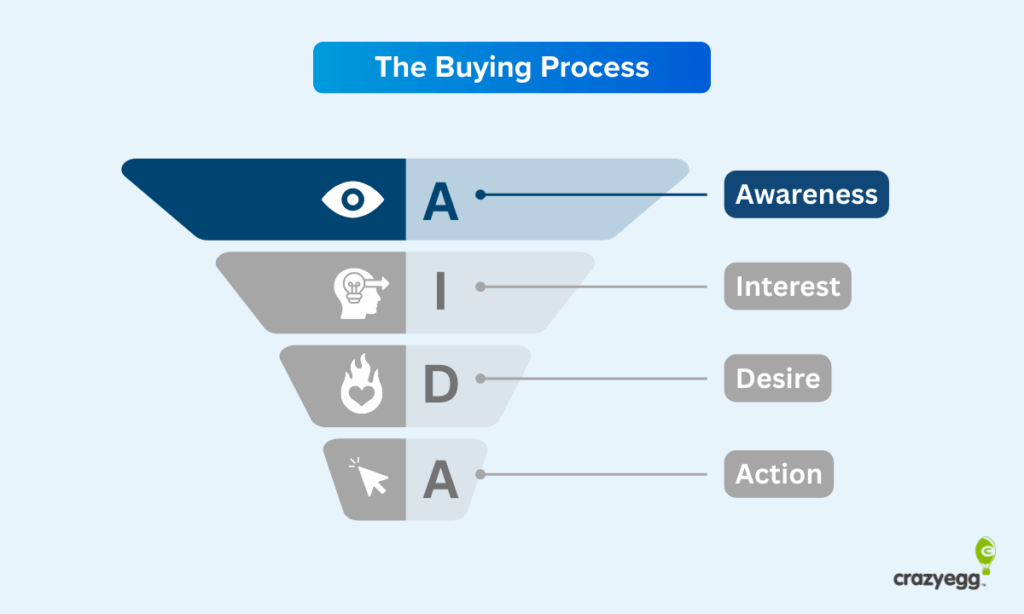
As soon as someone visits your site, by definition they have entered the website funnel. They are “aware” of your brand now, for sure, and Google Analytics logs the unique session.
There is a real, singular human who is exploring your site. If they could be a potential customer, they are now assessing whether or not your brand is worth their time, their trust, and potentially their money.
The goal at this stage is to get the right people to your website. Any marketing channel is in play so long as you can target the right crowd and make it easy to visit your site. Here are a few observations about the most common channel strategies to generate:
- Paid search: Great for getting in front of people with a problem or a question related to what your brand does. Consider pushing paid traffic to a landing page vs your home page.
- Paid social: Excellent for raising awareness among a highly targeted audience, especially local. Consider experimenting in vertical video ads, if you are not already.
- Organic search: Phenomenal long-term play (6-18 months minimum) to win high-intent traffic and authority in the market. Consider building this out in the background while you use a faster strategy to get traffic into your funnel in the near-term.
- Influencer partnerships: Useful for getting niche audiences into your website funnel. I’d stay away from influencers with 100k+ followings, and try to work with micro-tier influencers that have a small, dedicated audience.
Each of these channels comes with costs and tradeoffs. You have complete freedom to deliver whatever mix of traffic works best. It’s important to monitor how traffic from different sources performs.
Visiting your site is a major step in the process of becoming a customer. With a defined target audience, you can drive the discoverability of your brand among the people who are hungriest for what you offer.
Interest
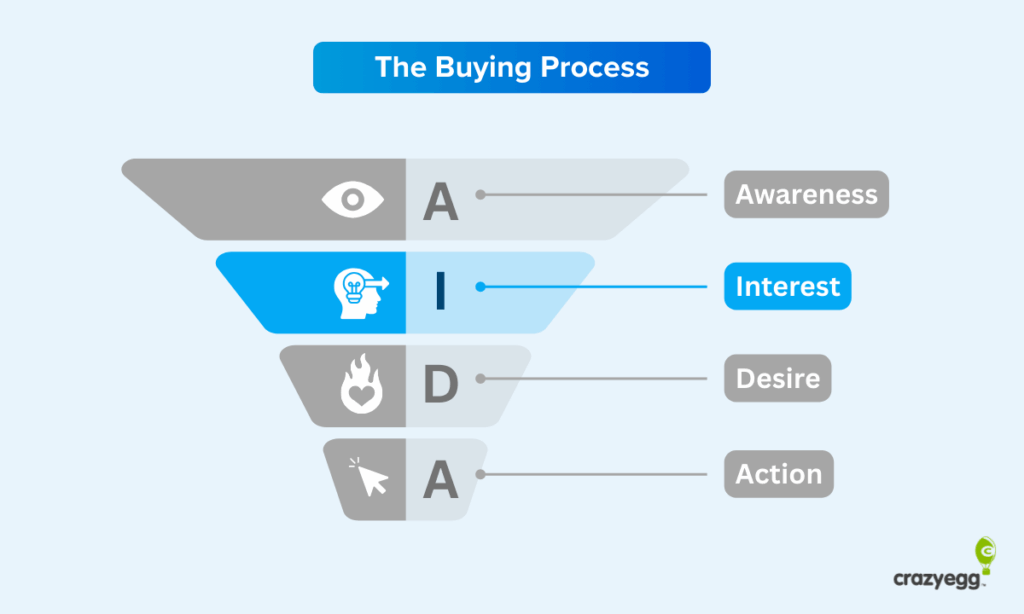
After you pull prospective customers into your funnel, you need to build their interest in your product or service. Your website content is the best tool for doing this.
Figure out what users need to know about your industry, services, and products. Determine what questions and needs they have. Then craft content that addresses those needs and positions your brand as an authority on the subject.
Write blog posts, explainers, and publish in-depth, informative guides that help your audience get a better understanding of what, exactly, you’re offering.
Content that keeps visitors interested and engaged is essential for helping your target audience get to know, like, and trust you. It’s also great for driving SEO traffic to your website, which is often a great source of high-intent leads.
Importantly, at this stage, website visitors are anonymous. They’re just browsing. They are actively interested in your content, but may not yet be interested in your product.
Some of them may never be, like people on your Careers page, or looking for the email of someone at your organization they want to sell to.
Don’t worry about those people. Focus your efforts on generating interest only among the segment of website visitors who are most likely to buy.
Provide content that truly helps that audience and shows them why your brand is worth believing. Keep them exploring your site. Make them want to follow you on social media.
What if they leave before getting to the next stage?
Many people will. It’s natural, normal, and the goal is to be able to get promising website visitors to reach out and start a relationship with your brand.
The most common way that brands encourage this is by using a lead magnet, which is something of value that people are willing to exchange their email address to get. Downloadable resources, access to gated content, discounts, and special offers are all common lead magnet offers.
An excellent lead magnet only appeals to people who could use your product or service. A free consultation for small business cybersecurity isn’t going to generate a ton of merely curious leads.
Some common ways to promote your lead magnet offer to website visitors include:
- Placing a call to action button in the navigation menu, near your primary offer, or elsewhere placed prominently on your site.
- Advertising your lead magnet with a banner, slider, or sidebar call to action.
- Using an opt in popup to make the offer after they land or before they exit.
A compelling lead magnet that offers real and relevant value to website visitors will convert a healthy number of people. Learn more about how to create a convincing lead magnet offer.
Once you have their email address, you can send more helpful content, get them back on your site, and through your funnel. This is an easy way to ensure that potential customers don’t forget about your brand altogether.
Desire
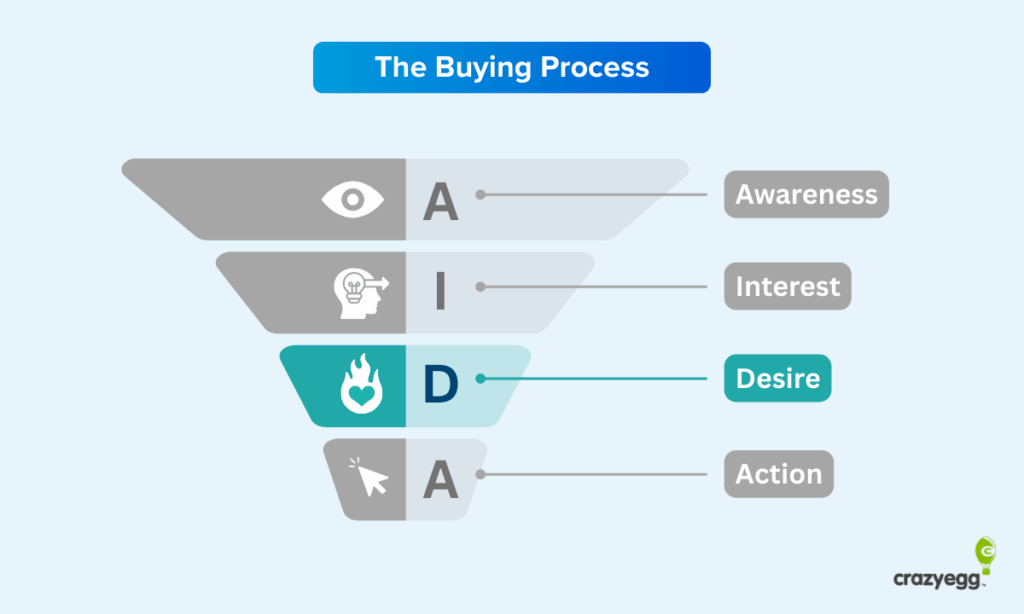
At this stage of the funnel, potential customers are doing their research. They are on the pricing page, reading product descriptions, or comparing your service with competitors.
The same content that built interest in your brand is no longer enough. Content at this stage has to show why your brand offers an irresistible solution. It should be in-depth, specialized, and tailored to a specific audience.
People want to see video demos of SaaS software, attend a webinar, or investigate a thorough whitepaper. Screenshots of the dashboard and big promises about performance won’t cut it.
On the B2C side, customers are looking for product specs to help them answer real-world questions. They want detailed FAQ pages, clear returns policies, and other content that helps them answer the “what ifs” that lead to hesitation.
Social proof becomes incredibly important. People who are thinking about a purchase are usually very interested in what your current customers say. Testimonials, reviews, and trust badges from reputable organizations go a long way towards lowering the perceived risk of saying yes to your offer.
Action
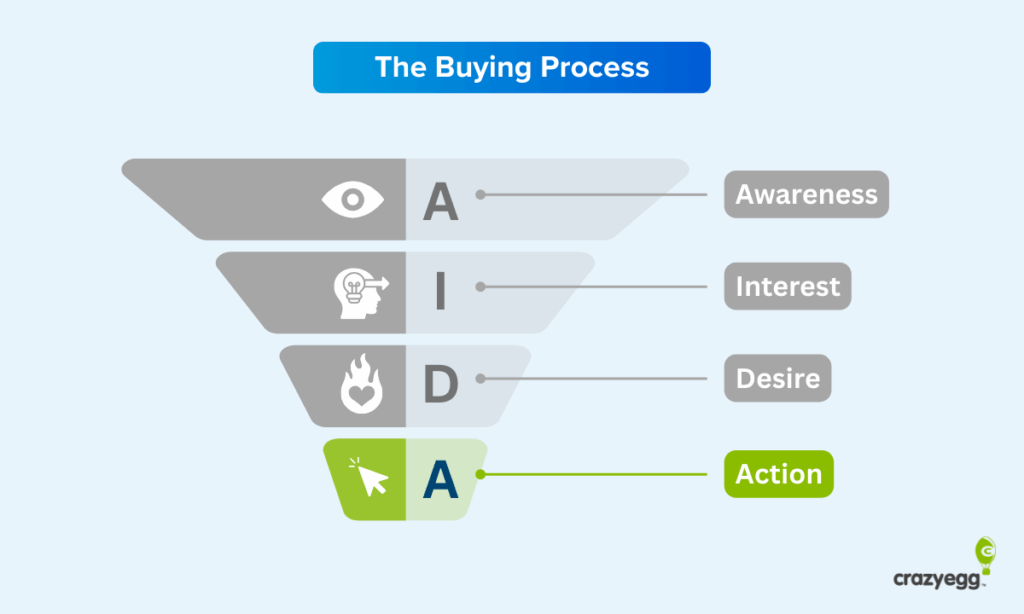
The final step to your funnel is action. At this point, users are adding products to their cart, filling out submission forms, and pulling out their credit card.
This is your ultimate goal, the big action you want your prospect to take.
Yes, they may have taken smaller actions already, like downloading a resource and engaging with your email content. But those small victories won’t pay the bills.
Content at this stage is free of distractions. It is entirely focused on making it as easy and appealing as possible to take action. It should check every box on this conversion optimization rate checklist.
You have already worked hard to generate interest and desire. Potential customers already have all the answers and information they need. There is no need to introduce anything new here.
Just reassure people your brand is safe, reinforce the value of taking action, and make the next step as simple as possible.
4 Steps To Set Up a Website Funnel That Tracks Conversions
1. Map out your ideal buying process(s)
An ideal buying process defines the basic steps customers take as they move through the entire website funnel.
To start developing your website funnel, think about how visitors move from their first interaction with your site to becoming a customer. If you’re not sure what that should look like, you can start by working backwards.
What are the most important goals on your site?
For most brands, the answer to this question is either sales or lead form submissions. Place that action at the bottom of your funnel.
Then, determine which other actions a user needs to take first in order to be ready to complete that step.
Here’s a simple example:
A SaaS startup selling software for recruiters buys ads on search and social media to drive traffic to a landing page designed to generate leads.
- Visit landing page
- Click through to demo registration page
- Fill out registration form
- Submit completed form
Every completed form is a fresh lead. And if the ads and landing page copy are aligned with their target audience, the quality of these leads should be very high.
Come on. The actual path real website visitors take is way more complex than that.
It’s true.
When I buy something on a website, especially from an unfamiliar brand, it doesn’t follow a neat flow. I cruise a few pages on the site to make sure the company is legitimate. I might read some customer reviews on a third-party site, go eat lunch, check out some competitors, and I could go on.
Yes, the actual buying process is incredibly messy.
The ideal buying process marks the major milestones that must be hit in order for someone to convert to a paying customer. It defines the boundaries of your website funnel stages, even if they don’t perfectly describe any individual customer experience.
Once you define these major events in your funnel, you can start to think about serving the right type of content to potential customers at every stage.
People who just became aware of your brand need to learn different things than someone who is actively comparing your solution against another.
And, without these stages defined, it’s impossible to monitor your funnel. How do you know if the actions people are taking are helping or hurting their chances of converting to a paid customer?
Should I track micro conversions in website funnels?
Micro conversions are smaller steps that customers take to become paying customers. Generally, these actions aren’t enough to move a potential customer from one funnel stage to the next, but they can be really helpful for gauging customer activity within stages.
Visitors can watch product videos, read reviews, look at answers to previously-asked questions, or check out special offers related to the product.
All of these actions are easy to track, and you can start to see the smaller steps that customers take before they convert.
What if I have multiple buying processes for the same conversion goal?
Not a problem. Most businesses do. For example, an online store might have track separate website funnels for different traffic sources.
- Direct search → home page → product page → add to cart → purchase
- Paid ad → landing page → add to cart → purchase
- Organic search → product page → add to cart → purchase
I’d map out any buying process that accounts for a meaningful fraction of successful conversions. Prioritize the largest conversion path, but plan to refine all of them over time.
What if I have more than one goal in a website funnel?
That’s normal and not a problem at all. You should map out the ideal buying processes for each goal.
Not everyone is ready to get out their credit the first time they visit an online store, for example, but they’ll happily trade their email address for weekly discounts and special offers.
In this case, figuring out how non-buying users become subscribers can be really important. Email marketing services offer many highly effective tools to nurture leads and convert them over time. Many ecommerce brands live and die by selling to their subscribers.
2. Set up funnel conversion tracking in GA4
With your funnel stages defined, the next step is aligning the way your web analytics platform collects data on user behavior. I use Google Analytics 4 (GA4), along with almost everyone else, so that’s what I’ll use here.
In GA4, page views, form submits, and other common customer engagement metrics are already tracked as events.
Is your conversion event logged already? See a complete list of automatically tracked events in GA4.
So long as the event you want to track is automatically logged by GA4 (many common conversion events are), then all you have to do is mark it as a key event.
Here are the steps for marking a key event in GA4:

The automatically tracked events in GA4 do not cover every event that could count as a conversion. You may have to set up tracking for these so-called recommended events, or set up a custom event to capture data on a user behavior that GA4 does not track on its own.
You can define up to 30 key events with GA4. If you are just starting out, I would track at least one key event for each stage of your funnel.
3. Bring the relevant traffic to your site
A website funnel starts from the moment your page loads on a potential customer’s browser, but it pays to think about how that person arrived.
When you are looking at creating a high-converting website funnel, it’s really important to attract only the potential customers with the most potential to become buyers.
When you use broad targeting in your initial ad campaigns, you’re essentially casting a wide net and hoping that some of the traffic you bring in turns out to be interested in your product or service.
The wider your net, the larger the percentage of your traffic will not be qualified (i.e. there is a low-to-no chance that they will become buyers). They will leave your funnel before even making it to the second stage.
Look at this example search engine ad from Crowdstrike, the well-known cloud security services provider.

I found this ad searching the phrase “how to secure a small business network,” and that is exactly what this advertisement speaks to.
Crowdstrike is known for enterprise security, but here they offer an eBook that’s perfectly suited for SMBs. They are using this ad to pull in a specific segment of their larger target market, directing them to relevant resources immediately.
The better you become at attracting high quality traffic, the more of your visitors will ultimately become customers. This will help you focus all of your marketing efforts on your most qualified leads.
I would start looking by looking at historical data in GA4 to see:
- What’s my ROI on paid traffic (split by source)?
- Which traffic sources account for most of my sales?
- Which traffic sources have the highest conversion rates?
- Which ad creatives have the highest click through and conversion rates
In addition to GA4, tools like Crazy Egg can be incredibly helpful for traffic analysis, letting you understand the relative performance of different campaigns, traffic sources, and landing pages.
Use what you discover to hone your ad targeting, content marketing, and attract the most likely buyers to your site.
4. Run a conversion rate optimization audit
Conversion rate optimization (CRO) is a little bit of art, a little science, and a lot of common sense. The idea is to ensure that your website is doing everything possible to help users convert rather than get in the way.
A CRO audit is a simple way to validate that web pages are:
- Fast
- Easy to use
- Simple to navigate
- Free of broken elements
- Usable on web and mobile
It’s distinct from the marketing and sales strategy that go into your building funnel. With few exceptions, CRO tactics are broadly applicable. Who thinks a slower site will improve the conversion rate?
This post walks you through how to run a quick CRO audit, which is mandatory in my opinion if you are serious about working on a website funnel.
Congratulations.
Your website funnel is strategically sound and accurately tracking user behavior on your site. Every day that goes by brings more data to help you better understand your customers and refine your funnel further.
Real Website Funnel Example: Full Walk-Through
Talking about the theory behind funnels is all well and good, but what does this look like in the real world?
Here is an actual B2B website funnel I went through while researching this post. We’ll use the AIDA frame here to make sure we are always thinking about what the customer needs at each clear step of their buying process.
Gaining awareness
In this example, I am playing the role of someone who needs new software for recruiting.
To start, I Googled, “software for recruiters,” which generated a results page with a few paid ads. I clicked on the first one, which looked like this:
The ad has a straightforward headline followed by concise copywriting that uses common persuasion techniques to sell people on “Recruitment software that actually makes your job easier.”

Not everyone is going to click through. And that is perfect. This company is paying for every click, so they only want people who have a real need for their product.
Even if I had never heard of this brand, were I a recruiter who was annoyed by how complex or clunky my current solution was, this company would now be on my radar. This brand is working to solve a problem I have.
Capturing interest
When we click through, we arrive on this landing page:
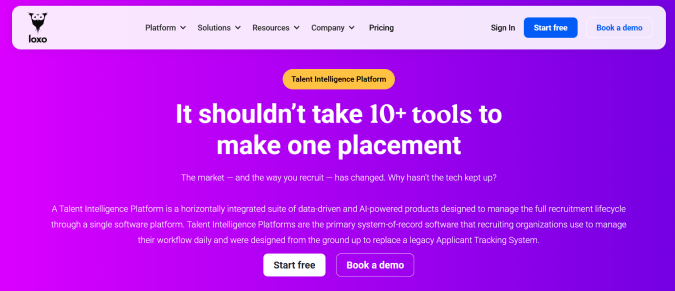
Here, the company positions themselves as a “Talent Intelligence Platform” and uses the headline “It shouldn’t take 10+ tools to make one placement.”
Notice how the language becomes more specialized on the landing page, but the offer stays the same. They are talking about placements and recruitment lifecycles, but the focus is still on making a real person’s life easier.
If I were a recruiter using 10+ tools to make a single placement, I’d definitely be interested in what this company has to say. Time to explore the rest of the landing page.
Sharpening desire
There is an offer I could click, “Start free,” as well as a secondary offer to “Book a demo.” But I am not ready to act, yet.
I just found out about this brand and there are thousands of options on the market. Plus, migrating to a new unified recruiting/HR platform? That is a huge undertaking.
I need to know more.
And so do most visitors on the landing page. There are hundreds of words, dozens of high-quality visuals, and links to additional resources. This company is not putting all this effort in just for fun.
They know that people need to be convinced.
For example, there is a customer testimonial spanning the entire landing page from an HR director at an executive recruiting firm.
This type of social proof is really important to present to potential buyers.

I don’t want to try something unproven, first of all, and I just heard of this brand. It’s not that I distrust them, it’s that I will trust the word of a third-party a lot more. I want to know what people in my shoes who already use the software think about it.
Below the appealing testimonial is a button that says “Explore customer stories”. I clicked through, and as promised there are dozens of case studies that evidence how this brand helps recruiting companies find success.
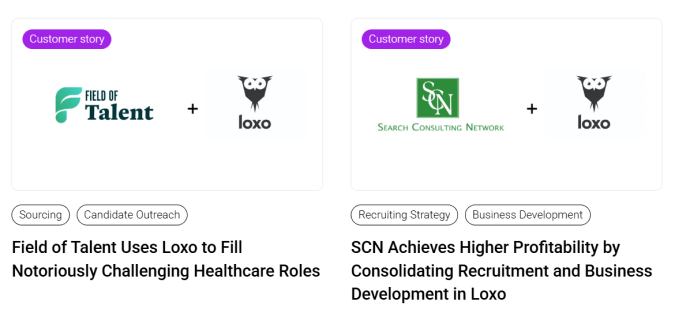
Stories focus on teams simplifying recruiting processes, finding new efficiencies, increasing profitability, and other benefits that real-world companies have experienced by using this software.
This is just one link from the landing page. There are many more links with similarly in-depth resources. There is also an interactive element, an ROI calculator companies can use to get a sense of the price, as well as a giant image of the company’s place on the G2 quadrant, a strong trust signal in this space.
This company recognizes that it is going to take more than just a great headline to convince people, and get them to sign up for a free trial.
Encouraging action
Once I was ready to take action, I clicked the “Start free” button, and came to a page with several signup options and another compelling customer testimonial.

At this point, the company is trying to do everything possible to reduce friction. There are zero distractions or alternate actions you can take.
Everything is stated as plainly as possible, and every effort has been made to eliminate confusion. For example, they’ve included logos for Google and Microsoft (certainly not unknown brands), and placeholder text in the form fields for both the email address and password dots.
My guess is that this company has A/B tested their landing page and discovered how to make the signup experience as easy as possible.
And that’s it. If I were the right buyer, I could have gone through this funnel and converted here.
In reality, though, this buying decision is going to take weeks or months, even at a relatively small business. I’d have to talk with people in HR, of course, but also legal, IT, and other departments. Is this really a viable solution for our company, tech stack, and regulatory environment?What I can say for certain is that this company has provided a website funnel that has resources for every stage of that long, complex customer journey.



